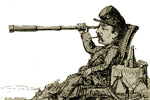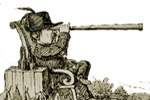Standing directly behind the boulder which holds the Signal Corps Monument,
you can see most of the signal station sites that were in use on the field.
The sites on Culp's Hill and Power's Hill are now obscured by timber. Take
your compass and sight the signal stations from left to right as follows:
Jack's Mountain - 265 degrees, Meade's Headquarters 35 degrees, Cemetery Hill
- 36 degreesi Culp's Hill 44 degrees, Power's Hill - 50 degrees- Although the
exact location of some of the Gettysburg signal sites are difficult to
pinpoint, it is well documented that the Little Round Top station was the
boulder holding the tablet and the one right behind it.
[E. B. Cope, Engineer,Letter,
War Department Gettysburg National Park
Commission,
Gettysburg, January 10, 1900.]
The history of the Signal Monument
is available for review at the National Park Service Library in the Cyclorama
building.
Report of Capt. Lemuel B. Norton,
Chief Signal Officer,
Army of the Potomac.
A station was established upon Round Top Mountain, on the left
of our line, and from this point the greater part of the enemy's forces
could be seen and their movements reported. From this position, at 3.30
P.M., the signal officer discovered the enemy massing upon General Sickles
left, and reported the fact to General Sickles and to the general commanding.
At 5.30 P.M. the enemy opened a terrific fire, but our left was fully
prepared for them, and the fight gradually extended to the whole front, so
that every signal flag was kept almost constantly working. The station at
Round Top was once, and that at General Meade's headquarters twice, broken
up by the rapid advance of the enemy and the severity of the fire, but were
immediately reoccupied when the positions became tenable.
[O.R., XXVII, Part I, p. 202.]
Much of the importance of
the Round Top signal station came from the fact that its mere presence caused
a delay in the employment of Longstreet's Corps on 2 July. The statior was the
direct cause of Longstreet's countermarch. Maj. Gen. Lafayette McLaws, one of
Longstreet's division commanders, recounts Longstreet's decision to
countermarch:
Suddenly, as we rose a hill on the road we were taking the
[Little] Round Top was plainly visible, with the flags of the signal men in
rapid motion. I sent back and halted my division and rode with Major
Johnston rapidly around the neighborhood to see if there was any road by
which we could go to into position without being seen. Not finding any I
joined my command and met General Longstreet there, who asked "What is the
matter?" I replied, "Ride with me and I will show you that we can't go on
the route, according to instruction, without being seen by the enemy." We
rode to the top of the hill and he at once said, "Why this won't do. Is
there no way to avoid it?" I then told him of my reconnaissance in the
morning, and he said: "How can we get there?" I said: "Only by going back by
counter marching-" He said: "Then all right," and the movement commenced.
But as General Hood, in his eagerness for the fray (and he bears the
character of always being so), had pressed on his division behind mine so
that it lapped considerably, creating confusion in the countermarch, General
Longstreet rode to me and said: "General, there is so much confusion, owing
to Hood's division being mixed up with yours, supposed you let him
countermarch first and lead in the attack-" I replied: "General, as I
started in the lead, let me continue so;" and he replied, "Then go on," and
rode off.
[Lafayette McLaws, "Gettysburg," Southern Historical Society Papers, Vol.
VII, p. 69.]
Take your compass and sight a red barn and metal
silo at 308 degrees. This is the location where the above conversations
between McLaws and Longstreet took place. You can see that McLaws was correct
in his assertion that he couldn't continue without being seen by the signalmen
at this station.
Col. E. P. Alexander, in charge of Longsteet's artillery and the founder of
the Confederate signal service, comments on the significance of the Round Top
signal station:
Ewell's corps, holding the extreme left, was to attack the
enemy's right on hearing Longstreet's guns. Longstreet was directed, in his
march, to avoid exposing it to the view of a Federal signal station on
Little Round Top Mountain.
Meanwhile, on the arrival of Longstreet's reserve artillery in the
vicinity of the field. I had been placed in charge of all the artillery of
his corps, and directed to reconnoitre the enemy's left and to move some of
the battalions to that part of the field. This had been done by noon, when
three battalions, - my own, Cabell's and Henry's - were located in the
valley of Willoughby Run awaiting the arrival of the infantry. Riding back
presently to learn the cause of their non-arrival, the head of the infantry
column was found halted, where its road became exposed to the Federal view,
while messages were sent to Longstreet, and the guide sought a new route.
[E. P. Alexander, Military Memoirs of a Confederate, New York,Charles
Scribner's Sons, 1910, pp. 391-392.]
The Round Top signal station was used by a number of two man signal
detachments representing the various corps to which they were temporarily
attached. A review of the message traffic indicates that Buford's signal
officer, Lieutenant Jerome, was the first to use the station on the second day
of the battle.
The following messages were sent before noon on 2 July:
Mountain Signal Station
July 2, 1863, 11.45 A.M.
Gen. Butterfield:
Enemy's skirmishers are advancing from the west, one
mile from here.
Jerome,
Lieut., Signal Officer
Round Top Mountain Signal Station
July 2, 1863, 11.55 A.M.
Gen. Butterfield:
The rebels are in force, and our skirmishers give
way. One mile west of Round Top Signal station the woods are full of them.
Jerome,
Lieut., Signal Officer
[O.R., XXVII, Part III, p. 488.]
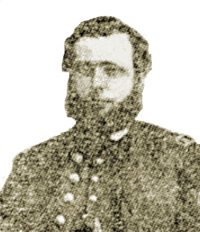
James Hall |
|
Jerome, attached specifically to support Buford's
division, evidently left the station when the division was pulled from Little
Round Top.
In view of the following message, it is probable that that the Chief Signal
Officer, Capt. Norton, joined Capt. P. A. Taylor at the Little Round Top
station. He brought the station to the attention of Capt. James Hall who along
with Taylor was attached to the Second Corps. You will note that although
Norton tells Hall that Little Round Top is a good observation station, he does
not direct him to occupy it. This message is typical of the indirect methods
Norton employed in fulfilling his duties as Chief Signal Officer.
Round Top Mountain Signal Station
July 2, 1863.
Capt. Hall:
Saw a column of the enemy's infantry move into woods on
ridge, three miles west of the town, near the Millerstown road. Wagon teams,
parked in open field beyond the ridge, moved to the rear behind woods. See
wagons moving up and down on the Chambersburg pike, at Spangler's. Think the
enemy occupies the range of hills three miles west of the town in considerable
force.
Norton, M.
Taylor, M.
Signal Officers
[P.S.]-This is a good point for
observation.
[O.R., XXVII, Part III, p. 489.]
Although the Second Corps signal party evidently did not render a specific
report of their Little Round Top activities, the available message traffic
indicates that Hall joined Taylor on the Round Top Station by at least 1:30
P.M.on the second of July. There are a number of opinions as to the utility of
Capt. Hall's actions which vary from his "saving the day", expressed by fellow
signalmen, to that he contributed to the problem by presenting confusing
information to Generals Butterfield and Meade.
J. Willard Brown, an enlisted signalman during the war and the postwar
historian of the U.S. Veteran Signal Corps Association, gives Hall much of the
credit for saving Little Round Top. According to Brown, Hall was responsible
for sending messages which caused Warren to visit the station, and then had to
convince the general that the Confederate troops were concealed in front to
the position.
Brown elaborates:
It was Capt. Hall's announcement that the enemy were moving
around Sickles's left that brought Gen. Warren to Little Round Top. When he
reached the station the enemy were under cover, and were scarcely visible
except to-eyes accustomed to the use of the field-glass. Capt. Hall found it
very difficult to convince Gen. Warren that the enemy's infantry and
artillery were there concealed. While the discussion was in progress the
enemy opened on the station. The first shell burst close to the station, and
the general, a moment later, was wounded in the neck. Capt. Hall then
exclaimed, "Now do you see them?"
[J. Willard Brown,
Signal Corps, U.S.A. in the War of the Rebellion,
New
York, Arno Press, 1974, p. 367.]
Although Hall's version of the account is certainly interesting, his
credibility may be suspect. Hall was the Vice President of the Veteran Signal
Corps Association and was a protege of Brown's. They visited the station on
Little Round Top on July 2, 1888, along with John Chemberlin who was Hall's
flagman, during an annual reunion of the organization. [Minutes of The
Thirteenth Annual Reunion of the U.S. Veteran Signal Corps Association, held
at Gettysburg, Pa., July 2 and 3, 1888.] Hall's version was probably recounted
to Brown during that reunion, 25 years after the actual event, and was almost
certainly colored by time and parochialism.
Harry W. Pfanz, a modern student of the battle, believes that the messages
which Hall sent to General Butterfield contributed to the confusion as to the
Confederate activity on the left. He postulates that the signal station could
have done a better job providing the Army with information.
[Harry W. Pfanz,
Gettysburg: The Second Day,
The University of North
Carolina Press, 1987, pp. 141-142.]
Hall sent the following traffic from Little Round Top on July 2, 1863:
Round Top Mountain Signal Station,
July 2, 1863, 1.30 P.M.
Gen. Butterfield:
A heavy column of enemy's infantry, about ten
thousand, is moving from opposite our extreme left toward our right.
HALL,
Officer, Signal Capt.
Round Top Mountain Signal Station,
July
2, 1863, 2.10 P.M.
Gen. Butterfield:
Those troops were passing on a by-road from Dr. Hall's
House to Herr's tavern, on the Chambersburg pike. A train of ambulances is
following them.
[O.R., XXVII, Part III, p. 488.]
Capt. Hall's party departed the station at some point in the afternoon and
left the station without a signal party. According to Brown, Col. Morgan
ordered Capt. Hall to report to Gen. Sedgwick.
[J. Willard Brown,
Signal Corps, U.S.A. in the War of the Rebellion,
New
York, Arno Press, 1974, p. 366.]
That the Round Top Signal station reported information on the disposition
of Confederate troops prior to Longstreet's assault on Sickles is confirmed by
Brig. Gen. Gibbon's aide, Lieut. Frank A. Haskell. Lieut. Haskell's "letter"
tells us:
About noon the Signal Corps, from the top of Little Round Top, with their
powerful glasses, and the cavalry at the extreme left, began td report the
enemy in heavy force, making disposition of battle. to the West of Round Top,
and opposite to the left of the Third Corps.
[Frank A. Haskell, The Battle of Gettysburg,
Edited by Bruce Catton,
Boston, Houghton Mifflin Company, 1958, p.31.]
The third signal party to assume position on Little Round Top was that of
Capt. E. C. Pierce of the Sixth Corps. At the time Capt. Pierce and his
detachment arrived, Capt. Hall had departed the site.
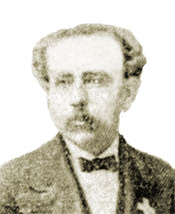
Edward C. Pierce |
|
Report of Capt. E. C. Pierce, Signal Officer, Sixth Army Corps
The 6th Corps reached Gettysburg at 2 o'clock p.m., July 2nd,
after a continuous march of nineteen hours. After resting three hours,
orders were given for the corps to proceed to the extreme left of our line
and engage the enemy.
Lieut. Geo. J. Clarke and myself assisted Gen. Sedgwick and staff in
forming the line of battle, and getting the troops in position, as the tide
of battle appeared to turn upon the celerity with which the 6th Corps was
engaged. The splendid manner in which our first line went in to the fight
fairly turned the tide, and at dusk we had repulsed the enemy at all points.
Before that consummation, we had learned that a signal station had been
abandoned by some signal officers as impracticable. It being described to us
a splendid post of observation, we determined to occupy it. The position, as
we eventually found it, was a pile of rock on our left and a little to the
right of the place occupied by Hazlett's battery. From it a magnificent view
of the entire battlefield could be had, extending from the cemetery, on our
right, to the Emmitsburg road on the left. We remained there during the
night.
July 3. At daylight we commenced making observations, the results of
which we reported by orderlies, to Major-Generals Meade, Sedgwick, Sykes,
Hancock, Birney, Pleasonton, Newton, etc.
Headquarters signal station was in plain sight all the time, and we could
hence call it, but not without exposing the lives of our men to the
deliberate aim of the enemy's sharpshooters, who, stationed behind rocks, in
tops of trees, etc., fired with fatal effect upon all that showed
themselves. They kept two guns of Hazlett's battery silent, except when
worked by volunteers, and kept up a continual fire upon the rock, not ten
feet square, occupied by us. Seven men, including officers, who were drawn
there by curiosity, were killed or severely wounded by the combined fire of
the sharpshooters and artillery. About 11 A.M. we were joined by Lieutenants
Wiggins and Camp, who agreed with us upon the impossibility of employing
flag signals, and consequently we continued to report by orderlies.
About 3 P.M., the enemy opened fire with all their artillery upon our
lines, and the necessity of sending orderlies increased as'Gen. Warren,
Chief of Engineers on Gen. Meade's staff, who came to our station at 2
o'clock, p.m. directed us to keep a lookout on certain points, and to send
messages every few minutes to Gen. Meade during the day. In this connection,
I wish particularly to place upon record the fact that the signalmen
attached toLieut. Wiggin's party and mine are worthy of all commendation for
the bravery displayed by them in riding to and for, through an unexampled
artillery fire, with important messages. During the afternoon of this day,
after the enemy were repulsed from our right and centre, Major-Generals
Meade, Sedgwick, Sykes, Pleasonton, etc., visited our station, and remained
there until Gen. Crawford's division drove the enemy and sharpshooters from
their position.
July 4th. We opened communication by flag signals with headquarters
station and made constant reports of the movements of the enemy. At 4
o'clock P.M., Lieutenants Wiggins and Camp reported back to Ist Corps by
order of Gen. Newton-"
[Capt. E. C. Pierce, report,
quoted in J. Willard Brown,
Signal Corps,
U.S.A. in the War of the Rebellilon,
New York, Arno Press, 1974, pp. 361-362]
Diary entry of Sergeant Luther C. Furst, USA, Flagman,
Sixth Army Corps
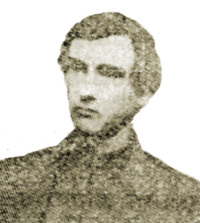
Luther C. Furst |
|
July 2d, 2 P.M. We have just made the second halt for orders. We
are now within four miles of Gettysburg. After a short rest advanced again.
Got up to our line of battle about 4 P.M., having made a march of thirty-six
miles, the longest rest being one hour. We immediately reinforce our troops
upon the left, they being pressed very hard. We just reach the conflict in
time to make secure the Round Top Mountain to our forces. The fight now
became general along the lines extending to Gettysburg, which is plainly
visible from this point. Our forces have been able to hold their positions
at every point. The 6th Corps came up the Round Top Mountain six lines deep,
secured and made safe our position on little Round Top. We immediately
established the signal station on the crest, the other signal officers
having deemed it impracticable.
July 3rd. Were up before daylight. Began to signal in direction of
Gettysburg at daybreak. Held our station all day, but were much annoyed by
the enemy's sharpshooters in and near the Devills Den. Have to keep under
cover to protect ourselves. The large rocks piled up all around us serve as
good protection- Today there have been seven men killed and wounded near our
station by the enemy's sharpshooters: hundreds on all sides of us by the
enemy's severe cannonading. Up to near noon there has been considerable
skirmishing along the line. A little later the whole of the artillery on
both sides opened up and shell flew fast and thick. A good many have been
struck near our station, but we are able to keep up communication. The fight
upon the right is said to have been very severe, but our trooos have held
their positions and repulsed the enemy at every point. The loss of the 6th
Corps has not been great, owing to the advantageous and protected position.
[Sergeant Luther C. Furst, Diary entry,
quoted in J.
Willard Brown, Signal CorDs, U.S.A. in the War of the Rebellion,
New York,
Arno Press, 1974, pp. 362 - 364]
As described by both Capt. Pierce and Sgt. Furst, on the third of July,
this station was under such fire that it lost its utility as a station of
communications but remained a station of observation. Messengers were used to
relay the information obtained by the signal parties to the army headquarters.
Historian George R. Stewart tells us: "Pickett began his advance from the
bottom of a swale, and for several minutes his lines moved forward without
anyone on Cemetery Ridge being able to see them. Almost at once, however, his
two front brigades came under observation from Little Round Top, and the alert
men of the Signal Corps sprang into action. The Vermonters of Stannard's
brigade, occupying low ground, knew that the attack was launched before they
saw a Confederate Flag or soldier."
[George R. Stewart, Pickett's Charge,
Boston, Houghton Mifflin Company,
1959, p. 179.]
If Stewart is correct in his assertion that the Vermonters knew that
Pickett's brigades were underway, they must have received the information by
courier from this station.
Now you should proceed to STOP 3. Return to TANEYTOWN ROAD (HWY 134) and
turn LEFT. Drive 1.4 miles and turn right on GRANITE SCHOOL HOUSE LANE. Drive
0.6 miles and stop along the road. You will see a monument in the woodline at
the base of a small hill to your left. This prominence is POWERS HILL. Walk to
the top of the hill and stop by the artillery battery monument. The hill is
heavily timbered, but in the late autumn and winter you can sight LITTLE ROUND
TOP at 235 degrees.


